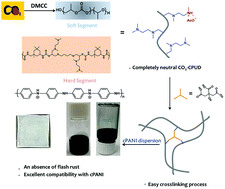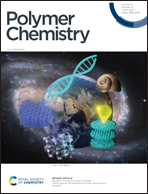Cationic polyurethane from CO2-polyol as an effective barrier binder for polyaniline-based metal anti-corrosion materials†
Abstract
The work discloses the use of CO2 polymer chemistry for the development of a sustainable metal anti-corrosion material. CO2-polyol, a poly(ether carbonate)diol from the telomerization of CO2 and propylene oxide catalyzed by zinc–cobalt double metal cyanide in the presence of a chain transfer agent, was used as a soft segment to prepare a waterborne cationic polyurethane dispersion (CPUD), which showed excellent hydrolysis and oxidation resistance owing to the coexistence of a hydrolysis-resistant ether unit and oxidation-resistant carbonate unit in CO2-polyol. Most importantly, to prepare a neutral CPUD dispersion compatible with an acidic conducting polyaniline, a delicately designed internal emulsifier was fabricated, in which 2,5,18,21-tetramethyl-9,14-dioxa-2,5,18,21-tetraazadocosane-7,16-diol (TDTD), combined with a sufficiently low steric hindrance tertiary amine, was used as the side chain extender (CE), with citric acid as a crosslinker. The internally crosslinked neutral CPUD was demonstrated to be compatible with a waterborne conducting polyaniline (cPANI) dispersion; the composite film obtained from the CPUD and cPANI dispersion showed a significant enhancement in barrier performance to protect against the penetration of corrosive molecules into the metal surface.

- This article is part of the themed collection: Sustainable Polymers


 Please wait while we load your content...
Please wait while we load your content...